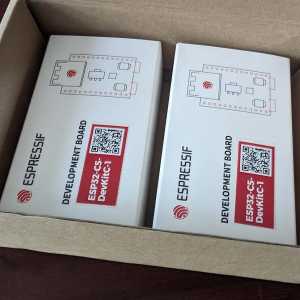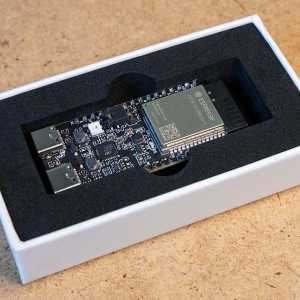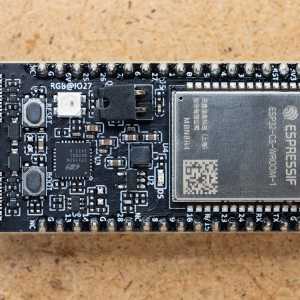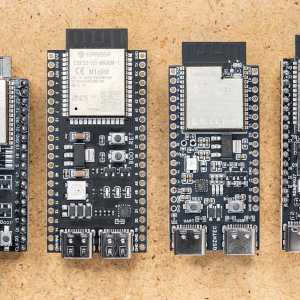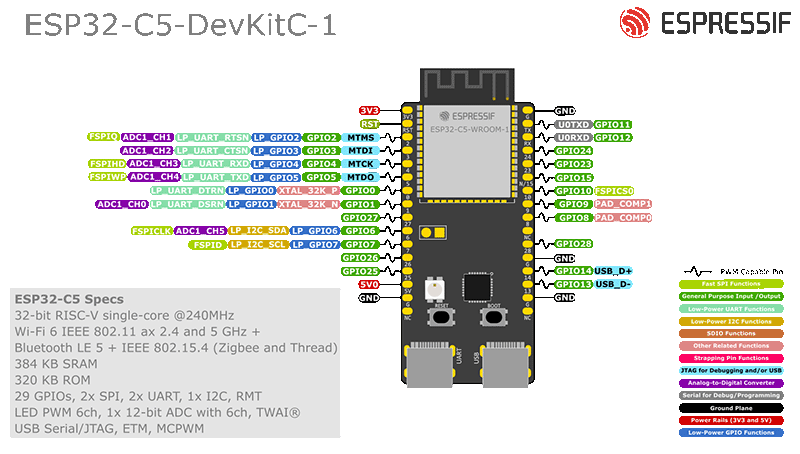ESP32-C5: Dual-band (2.4 & 5GHz) Wi-Fi 6 for IoT projects
With the ESP32-C5, Espressif is launching a member of the ESP32 family for the first time that supports the 5GHz band for Wi-Fi in addition to 2.4GHz – a decisive advantage for applications that rely on higher data rates, lower latency and a less congested frequency spectrum.
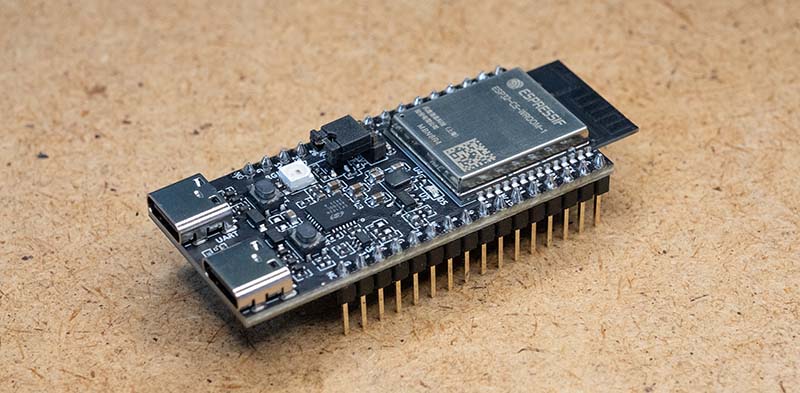
I was privileged to receive the pre-production ESP32-C5-DevKitC-1 development board directly from Espressif. Mass production is expected to begin soon. This article provides an overview of the chip's technical specifications, the development board, and initial experiences with Wi-Fi performance under real-world conditions.
What's new with the ESP32-C5?
The ESP32-C5 brings several significant innovations to the ESP32 family – at the radio, architectural, and system levels. The most noticeable innovation is support for dual-band WiFi: The ESP32-C5 is the first ESP32 chip that can operate in both the 2.4 GHz and 5 GHz bands. Architecturally, the ESP32-C5, like the C6, is based on a RISC-V dual-core design, consisting of a high-performance main core and a low-power core that can independently perform tasks – such as deep sleep or RTC functionality. The clock frequency has been increased from 160 MHz to 240 MHz for the HP core and from 20 MHz to 40 MHz for the low-power core. Additionally, the pipeline depth has been expanded from 4 to 5 stages. Another new feature is the Bit Scrambler Controller. It enables flexible data stream processing in the DMA path. It can be used for endianness conversions, data formatting, curve correction for ADC values, generating complex waveforms, or selectively inserting/removing bits. It features a small command engine and a 2048-byte lookup table per channel (TX/RX). Additionally, the C5 integrates new cryptographic and system functions such as:
- Key Management Controller (KMC) for secure key management in hardware,
- APM (Access Permission Management) for fine-grained access control to memory areas,
- Trusted Execution Environment (TEE) for separating security-critical code areas.
The block diagram from the preliminary datasheet provides an overview of all the components integrated into the ESP32-C5:
The table below shows how the ESP32-C5 compares to other members of the ESP32 family. Although the C5 is the most recent addition, this by no means means that earlier models are obsolete. In fact, some established ESP32 variants offer a more extensive range of peripherals and thus retain their specific strengths. One example of this is the ESP32-S3: It remains the only ESP32 (apart from the high-end ESP32-P4) that supports direct control of parallel LCD displays.
| Merkmal | ESP32 | ESP32-S3 | ESP32-C6 | ESP32-C5 |
|---|---|---|---|---|
| Release | 2016 | 2021 | 2023 | 2024 (Early Access) |
| CPU cores | 2 × Xtensa LX6 | 2 × Xtensa LX7 | 1× RISC-V HP | 1× RISC-V HP |
| Clock frequency | bis 240 MHz | bis 240 MHz | bis 160 MHz | bis 240 MHz |
| Pipeline depth | 7 | 5 | 4 | 5 |
| LP-Core | ULP (proprietär) | ULP (proprietär) | RISC-V LP 20 MHz | RISC-V LP 40 MHz |
| SRAM | 520 KB + 16 KB RTC | 512 KB + 16 KB RTC | 512 KB + 16 KB RTC | 512 KB + 16 KB RTC |
| Wi-Fi | 2.4 GHz b/g/n | 2.4 GHz b/g/n | 2.4 GHz b/g/n/ax | 2.4/5 GHz a/b/g/n/ax |
| Bluetooth | BT + BLE 4.2 | BLE 5.0 | BLE 5.3 | BLE 5.0 |
| 802.15.4 (Zigbee/Thread) |
✘ | ✘ | ✔ | ✔ |
| GPIOs (max) | 34 | 45 | 30 (QFN40) 22 (QFN32) |
27 (QFN48) 19 (QFN40) |
| ADC (channels) | 2×12-bit (18) | 2×12-bit (20) | 1×12-bit (7) | 1×12-bit, (6) |
| DAC | 2× 8-bit | ✘ | ✘ | ✘ |
| PWM (Kanäle) | max 16 | max 8 | max 6 | max 6 |
| RTC support | ✔ | ✔ | ✔ (own LP-Core) | ✔ (own LP-Core) |
| Peripherals | 4×SPI, 2×I2C, 2×I2S, 3×UART, CAN, RMT | 4×SPI, 2×I2C, 2×I2S, 3×UART, CAN, RMT, USB OTG, LCD, DVP | SPI, I2C, (LP) I2C, I2S, 2×UART, (LP) UART, CAN, RMT, USB OTG | SPI, I2C, (LP) I2C, I2S, 2×UART, (LP) UART, CAN, RMT, USB OTG |
| Crypto-HW | AES, SHA, RSA, ECC, RNG | AES, SHA, RSA, RNG, HMAC |
AES, SHA, RSA, RNG,, HMAC, ECC, APM | AES, SHA, RSA, HMAC, ECC, ECDSA, APM |
5 GHz Band for Wi-Fi
The highlight of the ESP32-C5 is, of course, its support for the 5 GHz Wi-Fi band. This marks the first time that Espressif has expanded the wireless technology of its microcontrollers, which was previously limited exclusively to 2.4 GHz. Using the 5 GHz band offers several advantages: higher possible data rates, lower latency, and, above all, a significantly less congested frequency spectrum – especially in densely populated Wi-Fi environments or when multiple devices are used in parallel.
Although the ESP32-C5 uses a simple 1×1 configuration (1T1R) with a maximum channel bandwidth of 20 MHz in client mode, the chip offers a modern Wi-Fi implementation: It is fully IEEE 802.11ax (Wi-Fi 6) and 802.11ac compliant, supporting technologies such as downlink MU-MIMO, beamforming (as a beamformer), OFDMA, and Target Wake Time (TWT) for energy savings. In ideal configurations, gross data rates of up to 150 Mbps are possible, for example at 40 MHz in the 2.4 GHz band (802.11n), or around 143 Mbps at 20 MHz in the 5 GHz band (802.11ac/ax). The practical net data rate is typically between 30 and 70 Mbps – depending on the environment, access point, and protocol overhead.
To evaluate these theoretical possibilities and advantages in practice, I conducted measurements with the network performance tool iPerf. I used a FRITZ!Repeater 1200 AX as the access point and remote station for the ESP32-C5, as my router doesn't yet support Wi-Fi 6. In addition to the C5, I also tested several other ESP32 variants to better understand the results. The access point was about two meters away during the measurements.
| TCP Mbits/sec | UDP Mbits/sec | |
|---|---|---|
| ESP32 | 45.3 | 74.1 |
| ESP32-S3 | 46.2 | 75.3 |
| ESP32-C6 | 25.2 | 41.3 |
| ESP32-C5 2.4 GHz | 47.5 | 62.5 |
| ESP32-C5 5 GHz | 47.3 | 65.6 |
Since Espressif sent me two ESP32-C5 DevKits, I also tested the communication between the two microcontrollers:
| TCP Mbits/sec | UDP Mbits/sec | |
|---|---|---|
| 2.4 GHz | 26.9 | 22.4 |
| 5 GHz | 36.7 | 29.1 |
The results show that the main advantage of the ESP32-C5 lies less in the peak data rates, but rather in the option to use the less frequented 5 GHz band. However, there were considerable fluctuations in the measurements, and I've had the impression in the past that the ESP32 doesn't quite mesh with the FritzBox. Therefore, these results should be treated with some caution.
ESP32-C5-DevKitC-1
The ESP32-C5-DevKitC-1 came in a rather elegant package for a microcontroller. In addition to the usual boot and reset buttons, the board is equipped with an RGB LED and a native and UART USB port. Additionally, there's a jumper directly in the ESP32-C5's power supply, which allows for isolated measurement of the SoC's power consumption—i.e., without the influence of the voltage regulator, LED, and other board components.
The board offers 8 MB of external flash and 4 MB of PSRAM, which should be sufficient even for more complex applications. The following diagram from Espressif shows the board's pinout.
Development with the ESP32-C5-DevKitC-1 has been possible since version 5.4 of the ESP-IDF framework, even though it is still a preview. Official support for the ESP32-C5 will begin in version 5.5, which, according to the roadmap, will be released mid-year. An official programming guide is already available.
I normally use Visual Studio Code with the PlatformIO plugin for ESP32 development. However, I was unable to compile the iPerf tool with it, even though the current version 6.10.0 of the plugin supports ESP-IDF 5.4. Therefore, I used Espressif's ESP-IDF plugin for testing. No errors occurred with this plugin and the current version 5.4.1 of the ESP-IDF framework.
Conclusion
First, I would like to thank Espressif for providing the pre-production boards. The most important innovation of the ESP32-C5 is without question the support for dual-band Wi-Fi. But the increased CPU performance also makes it the most versatile microcontroller in the ESP32 family at the moment. I wouldn't be surprised if more devices such as robot vacuum cleaners or 3D printers, which currently only support 2.4 GHz Wi-Fi, also support dual-band Wi-Fi in the future. Perhaps the ESP32-C5 will also replace the ESP32-C6 as the wireless coprocessor on the ESP32-P4 development boards in the future. In any case, I will be using the ESP32-C5 for my next projects.
Update 30.04.2025: Today, Espressif announced the start of mass production. The board can be ordered on AliExpress for just under 16 euros. However, only one board per customer is allowed.
